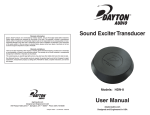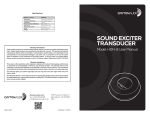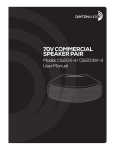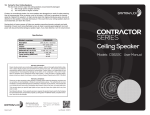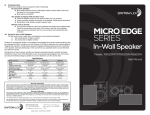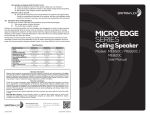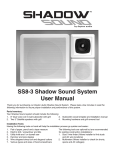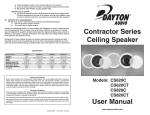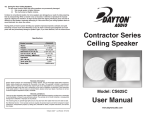Download IO Series Manual.indd
Transcript
10) Caring For Your Outdoor Speakers The two most common ways that outdoor speakers are permanently damaged: 1) Not enough power at higher volumes. 2) Too much power at higher volumes. Contrary to conventional wisdom, far more speakers are damaged as a result of under-powering, than by overpowering. When a receiver runs out of power, it still tries to reproduce the musical signal by “clipping” the waveform. At high volume levels this clipping introduces extreme amounts of distortion energy to the speaker, eventually destroying it. If the sound from your speakers starts to sound distorted, turn down the volume. Having plenty of reserve power will help your speakers reproduce dynamic contrasts and quick transients of music much more effectively, but use good judgment; too much power will also permanently damage a speaker. Again, if you hear distortion or audible distress, turn the volume down. Outdoor speakers are designed to withstand outdoor environments, including incidental exposure to water. They are not designed to be washed using a pressure washer or hose nozzle. If debris accumulates on the housing of the speaker, use a damp sponge or cloth to remove it. Specifications Model number IO525B/W IO525BT/WT IO655B/W 2-Way Indoor/Outdoor Speaker Pair IO655BT/WT Description Indoor/Outdoor Speaker Indoor/Outdoor Speaker Indoor/Outdoor Speaker Indoor/Outdoor Speaker Woofer 5.25" Mineral-Filled Poly 5.25" Mineral-Filled Poly 6.5" Mineral-Filled Poly 6.5" Mineral-Filled Poly Tweeter 1" Metallized Mylar Dome 1" Metallized Mylar Dome 1" Metallized Mylar Dome 1" Metallized Mylar Dome Frequency Response 55-20,000 Hz 55-20,000 Hz 45-20,000 Hz 45-20,000 Hz Impedance 8 8 Ohms or 70V 8 8 Ohms or 70V 70V Taps No Transformer 4W, 8W, 16W, 30W No Transformer 4W, 8W, 16W, 30W Power Handling (RMS/Peak) 40W / 75W 40W / 75W 50W / 85W 50W / 85W SPL 1W/1m 85 dB 85 dB 87 dB 87 dB Dimensions HxWxD 9.5" x 6.75" x 7.25" 9.5" x 6.75" x 7.25" 11" x 8.25" x 8.75" 11" x 8.25" x 8.75" Color B = Black BT = Black B = Black BT = Black W = White WT = White W = White WT = White Weight 5.2 lb / 2.4 kg 5.9 lb / 2.7 kg 6.7 lb / 3.0 kg 7.2 lb / 3.3 kg Warranty Information Dayton Audio® products are constructed by industry experts, and are thoroughly tested before shipment. Dayton Audio products are warranted for the period of one year. This warranty is limited to manufacturer defects, either in materials or workmanship. Dayton Audio is not responsible for any consequential on inconsequential damage to any other unit or component or the cost for installation or extraction of any component of the audio system. In the rare case of a product failure, please contact your place of purchase or call our Customer Support Department at (937) 743-8248. Warranty Limitations There are no other warranties, either express or implied, which extend the foregoing, and there are no warranties of merchantability or fitness for any particular purpose. The warranty will not cover incidental or consequential damage due to defective or improper use of products. This warranty gives you specific legal rights and you may also have other rights which vary from state to state. Non-Warranty Service: If non-warranty service is required, the product may be sent to the Company for repair/ replacement, transportation prepaid, by calling (937) 743-8248 for details, complete instructions, and service fee charges. daytonaudio.com Designed and Engineered in USA P.O. Box 52 • Springboro, OH • 45066-052 • Phone: (937) 743-8248 © Dayton Audio® Last Revised: 10/11/2012 Models: IO525B/W/BT/WT IO655B/W/BT/WT User Manual daytonaudio.com Designed and Engineered in USA Congratulations on the purchase of your Dayton Audio® IO-Series Indoor/Outdoor Speakers. These rugged, all-purpose speakers are designed to deliver reliable, high-quality audio while withstanding harsh outdoor environments. They feature weather-resistant construction, high-quality components, and exclusive acoustic design and tuning by Dayton Audio for outstanding performance and value. Robust polypropylene cone woofer with rubber surround 1” Metallized Mylar Dome Tweeter ● Optimized crossover for perfectly balanced sound ● Available in black or white finish; 70V versions available longer runs we recommend 14 gauge or larger cable. (Wire size is less important for 70-volt distributed audio applications but may still affect performance.) Note that most municipalities require the use of CL2 rated speaker cable for cable runs through walls and ceilings. Leave enough excess speaker cable so you can stand comfortably on the floor or ladder while connecting the speaker cable to the speakers. If mounting the speakers outdoors, you may wish to fill the hole that the speaker wire passes through with a caulking material to prevent water intrusion and cold air infiltration. ● ● 6) Please read these instructions completely before you begin your installation. 1) Parts Inventory Your speaker kit should include the following: ● 2 Dayton Audio Indoor/Outdoor Speakers with Grilles ● 2 color-matched mounting yoke brackets ● 4 Endcap Screws 2) Installation Tools The Dayton Audio speakers can be installed with the following simple tools: ● Pencil ● #2 Phillips screwdriver ● Wire cutters & wire stripper/crimp tool ● Drill & drill bits ● Stud finder** Note: If you have an 8-ohm model, no further configuration is necessary. If you are installing a distributed 70-volt (70V) system, be sure to use the appropriate speaker model (70V version) and use the selector knob on the rear of the speaker to choose the transformer tap that provides the desired acoustic output. When the 70V model is used with a 70V system, do not select the “8-Ohm” tap. 7) ** Optional tools to make the installation easier. 3) Speaker Location Because of their well-behaved off-axis response and excellent dispersion, your new Dayton Audio speakers are less critical to position than most loudspeakers. Simply place them 5-8 feet apart wherever you desire music for the best possible performance. If you will be installing your speakers outdoors, select locations facing your listening area that are protected from rain, snow, and direct sunlight for extended product life. 4) Speaker Installation Once you have selected the location for your speakers, you are ready to install them. CAUTION: Be certain that there are no electrical wires, water pipes, or heating ducts in the planned installation area before you begin drilling. If there is an electrical outlet nearby, turn off the circuit breaker to avoid possible injury. Your Dayton Audio indoor/outdoor speakers are compact, but substantial in weight. They should be mounted into solid structure, not drywall. If drywall mounting is required, use highstrength anchors designed for heavy loads such as light fixtures. To avoid personal injury, please make sure the location you choose for mounting your indoor/outdoor speakers can safely support their weight. To mark the proper locations for drilling, remove the yoke-style mounting brackets from the rear of the speaker enclosures by removing the endcap screws, which are the large, round plastic dials at either end of the speaker. Place the yoke bracket against the mounting surface and choose the holes you want to use for mounting. Then use a pencil to mark the hole locations on the mounting surface prior to drilling. Remove the yoke bracket before drilling the holes, in order to avoid damage to the yoke bracket. After drilling the mounting holes, install the yoke bracket firmly to the mounting surface using the supplied mounting hardware. 5) Speaker Cable Don’t compromise sound quality by using thin, inexpensive speaker wire. We recommend using a high quality oxygen free copper two-conductor speaker cable. For low-impedance applications (8 ohms) and runs less than 50 feet we recommend 16 gauge cable, and for Speaker Connection Remove about 8” of the cable jacket to expose the inner conductors. Strip 1/4” of insulation from each conductor and connect to the speaker terminals. When connecting the wires to the speakers, be sure to observe proper polarity for the best sound. Most CL2 rated speaker cable has red and black conductors within the jacket, so connect the red wire to the red speaker terminal and the black wire to the black speaker terminal. The red (+) terminal on the back of the speaker should correspond to the red (+) terminal on the amplifier, and same for the black terminal. The speaker terminals are of the push-type, so push in on each terminal to allow the wire to be inserted. Torquing the terminal in any way is not necessary. Final Installation To install the speakers into their final location, place them into the yoke brackets and align the threaded inserts in the enclosure for the endcap screws with the matching holes in the yoke brackets, then install the endcap screws. Select an angle for the enclosure that will allow the entire listening area to be within line-of-sight of the tweeter dome, which is visible through the grille, and then tighten the endcap screws by hand. At this time, installation is complete. CAUTION: Do not over-tighten the endcap screws. Too much torque may strip the steel threaded insert or the plastic knob and the speaker will not seat securely in the yoke bracket or may produce audible vibration. A snug fit is all that is necessary to assure proper performance. 8) Painting Speakers If you choose to paint the speaker grill and/or housing, be sure to cover the woofer and tweeter, which are not paintable. Also do not paint the terminals or threaded inserts. Remove the grille for painting separately from the enclosure. Do not try to paint the frame and grill assembly together -- the grill should always be painted separately. Do not apply heavy coats of paint to the grill that might block the perforations in the grill and decrease audio output. Application by spraying is recommended. 9) Troubleshooting Should your speakers not work properly, check the following: No sound from speakers or quiet/strange sound: ● Make certain you observed proper polarity for both speaker inputs. Check the connections at the back of the receiver, and then at the speaker. ● Most stereo receivers have an A/B speaker selector switch. Make certain that this switch is in the proper position, and that the proper audio source is selected. ● Mute feature or protection mode is activated. Check for short circuits in speaker wiring. One speaker is playing while the other is not playing or plays quietly: ● Check the balance control on the receiver. Make sure it is centered. ● Loose connection at either the receiver or the speaker. Double check connections. ● Bad speaker cable. Replace suspect speaker cable. Receiver cuts on and off: ● This could be caused by a short circuit between the positive and negative leads. Check the connections at the back of the receiver, and then at the speaker; make sure that no strands of wire from one connector are touching the other connector.


